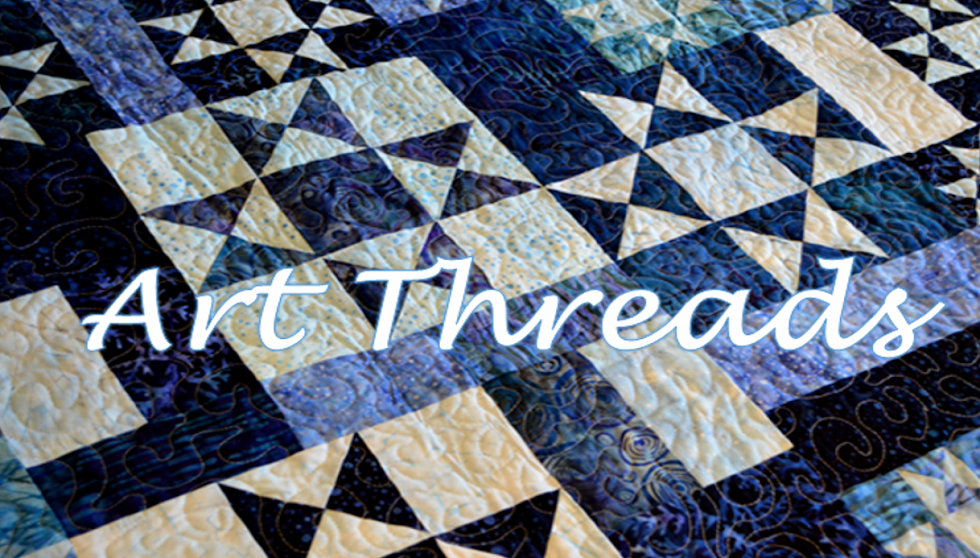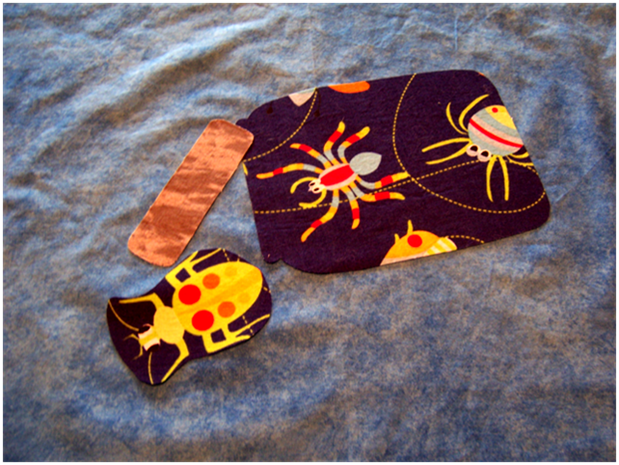Recap: When we last saw our busy quilters, they were madly measuring and appliqueing fabric jars of bugs onto a quilt top!

After you complete your quilt top (
see last Wednesday's posting here), you're ready to put your quilt together. For this you need:
-
a quilt top - this is the piece of fabric you just appliqued the bug jars onto
-
batting - this is the fluffy stuff that goes in the middle of quilts. You can get regular batting that you pin in place and iron on batting that has an adhesive on each side that sticks to your quilt top and backing when ironed. This sounds better than really is - whichever type of batting I use, I always think the other one would've been a better choice! The iron on doesn't actually stay in place, so you have to keep readjusting it anyways. It's really good for small quilted projects, but I wouldn't want to attempt anything larger than a lap or baby quilt with it.
-
quilt backing fabric - your choice here, but if you made a cotton fabric front, I'd stick with a cotton fabric back. I chose stars.
-
quilting machine needles - these are sharper and work much, much better than regular sewing machine needles when you're going through all those layers.
-
machine thread - I just use my usual thread, but there is quilting thread - it's thicker.
-
binding - this covers the edges of your quilt after you've quilted it. You can make binding (
see this past post) or buy it. I'm using purchased satin blanket binding.
-
large safety pins - to baste if you're using non-iron on batting and to baste after you have to loosen your iron on batting
-
quilting foot for your machine - this foot helps all the quilting layers move under the needle at the same rate so you don't end up with puckers. It grips the top layer as the feed dogs move the bottom layer along. The Brother 6000i I use comes with one that also has a stitch guide to help you sew straight quilting lines. If your machine didn't come with one, you can probably buy one at a sewing center. It's also possible, just a little harder, to quilt with a regular foot. You'll just have to work harder to keep puckers from forming.
1. Find a large flat spot to lay out your pieces. Lay the backing on the bottom and the batting on top. At this point, I like to pin the backing to the batting. . .
and then lay the quilt top on top.
2. If you are using iron on batting, follow the instructions for ironing/fusing it. If you are using regular batting, place safety pins about every six inches apart to hold it together.
3. With the Brother machine, you need to take off the regular shank to put your quilting walking foot on. Use the screwdriver that came with your accessories and take off the screw that holds the regular shank on.
4. Put the quilting foot on. I like to have the line guide on the left since it's hard to bunch the quilt up against the machine and still use the quilting foot.
5. Draw a line with chalk or some other removable marking tool down the center of your quilt.
6. Sew a straight line along the line you just marked. Because you're sewing through a lot more layers than usual, it's a good idea to sew on a test piece to make sure your tension is okay.
7. Line your guide up on the line you just quilted. Quilt your next line.
8. Continue in this way until you have quilted the first half. Turn your quilt the other way and use the line guide to quilt the other half. You'll need to keep readjusting the pins to keep from getting puckers. If you're using iron on batting you'll most likely need to reposition it a couple of times.
Guiding the quilt can be tough - some people use quilting gloves to help hold the fabric. You can buy them, or you can buy a cheap pair of gloves at the dollar store and use puffy paint to put "grabbing" lines along them.
9. When the entire quilt is finished, trim the edges.
10. Next, attach the binding. Binding has one side that's shorter than the other. You'll want to pin the shorter side on the top of the quilt - this helps you make sure you're catching the bottom layer of binding in the sewing. First, pin binding along one side and sew it in place. Don't cut the extra off.
11. To make a mitered corner, fold the corner as shown below.
12. Make sure the back of the corner looks as nice as the front, pin, and sew along the next quilt edge.
13. When you get to the end of the binding or the end of the quilt, turn end under about 1/4 inch.
14. Fold as shown below.
15. Put mitered edge over the already sewn edge and pin. Sew binding on and then hand sew the diagonal seam in a hem stitch. Depending on the length of your binding, you'll probably have to do this twice.
Iron and enjoy!
Happy Creating! Deborah
























































